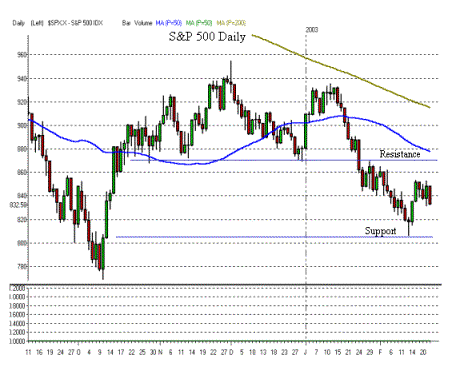Why Market Opinion Is A Deadly Game
It was pointed out to me that in
my last column I did not address my market
outlook. I’ll be happy to share that with you, but first I thought I’d express
some thoughts about how I develop my market opinion. More important, I want to
discuss the value of market opinions.
Like most traders, I look at many different indicators when trying to determine
the most likely direction of the market. I’m sure many of you look at similar
indicators. Some of the things I evaluate when forming my market opinion
include:
-
The success or failure of my
own recent trades -
The action of potential
leading stocks -
Price and volume action in
the major indices -
Sector action
-
Sentiment and
overbought/oversold indicators -
Breadth indicators
I also read and listen to a few
select market commentators that I have great respect for. These include several
of the TradingMarkets commentators. Trusting what anyone else has to say about
the market can be dangerous, but I read and listen to these select few to see if
they are spotting something that I am not.
After all that hard work is done, I’ll then have my opinion of what I believe is
the most likely scenario for the market. The value I assign to this
well-thought-out opinion that I’ve developed through observing, reading, and
studying is this: It’s almost worthless. I’d certainly never enter a trade based
on it.
Forming an opinion about the market and using that opinion to anticipate market
action is a deadly game. Reacting to the market is what’s important. Market
opinion should not be used to enter trades. Market opinion should be used to put
together a game plan to maximize profits if you are right, and minimize damage
if you are wrong.
The game plan you put together will vary depending on your time frame, and the
type of trader you are. For example,
Don Miller might say that he is not interested in long trades until the
market is north of hourly support.
Tim Truebenbach would normally wait for a follow-through day before
committing money to the long side. Mark
Boucher limits his trades to only those that meet his strictest criteria and
then still only takes on a maximum of two trades per week unless he feels there
is a clear market direction.
Your market opinion is your best guess at what the market may do. Based on that,
you should be able to put together a game plan. If you are right, and are able
to execute your game plan, you should be able to make some profits. Every game
plan should also account for the possibility that you are wrong. As
Gary Kaltbaum says, the market doesn’t care what you think. It’s going to do
whatever it wants.
From my standpoint, we seem to be in a bit of a no-man’s land right now. There
doesn’t seem to be a clear direction. The market is bouncing up and down on
light volume and there is neither strong upside conviction nor downside panic. I
think we are more likely to go down below 800 in the S&P 500
(
$SPX.X |
Quote |
Chart |
News |
PowerRating) than we are to go
above 870, but a move beyond these levels in either direction would likely
provide more clarity.

Now that you know my “nearly
worthless†market opinion, I’ll explain how I am using it. I am being careful on
both the long and the short side right now — especially long. Being careful
means doing everything I can to control my downside risk in new trades. This
includes:
-
Only trading ideal candidates
-
Adjusting position size
-
Making sure stops are not too
far away, and -
Taking partial profits so
that I can get my trade to breakeven as quickly as possible.
When I have a strong bias in
one direction or the other, I will trade more aggressively in that direction. If
the market provides me more evidence that we are going to test the October lows,
I will get more aggressive on the short side. If I start seeing strong
indications that lead me to believe we are going to get a nice upside move, then
I will get more aggressive on the long side. I will always consider trades in
either direction. I DO know what a good trade set
up looks like. I DON’T know what the market is
going to do tomorrow. I always have a list of candidates for either
direction. My bias determines the amount of risk I am willing to accept in a
trade, depending on its direction.
From now on, I’ll try and
remember to put in a few words about the market in my commentary. Just don’t put
too much stock in my opinion. I don’t.
Good Trading,
Rob Hanna
P.S.
Garmin Ltd.
(
GRMN |
Quote |
Chart |
News |
PowerRating), which was the “Opposite George†trade I
mentioned on
Wednesday, never triggered short. It has also consolidated nicely since
then — a good sign for those long this stock.
